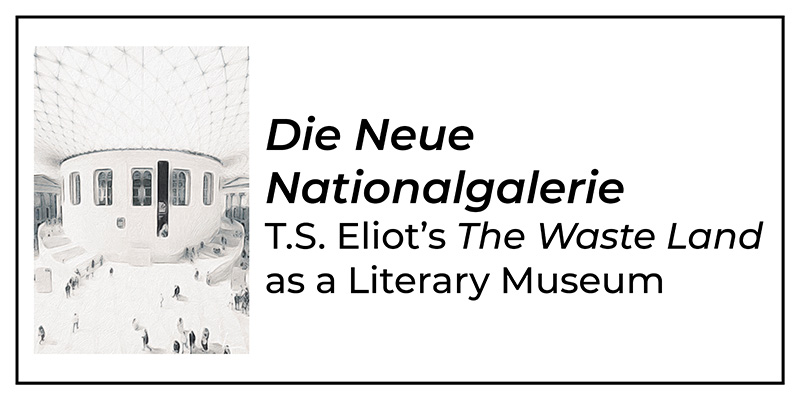Full Title: “Die Neue Nationalgalerie: T.S. Eliot’s The Waste Land as a Literary Museum”
Conference: Pacific Coast Conference on British Studies (PCCBS)
Location: Las Vegas, NV
First Presented: February 27, 2015
Original Abstract
The British Museum underwent a series of rapid expansions in the later part of the 19th Century coinciding with the ever-increasing collection of territories administered by the Crown. While the United Kingdom’s extensive land holdings eventually reached its zenith, the British Museum continued to germinate as it sought to contain the increasingly complex vision of the Empire and to entice the audience with perpetually new spectacle.
By the 1920s, the museum was a common feature in the cultural landscape of London and a place of interest for the intelligentsia, including Thomas Stern Eliot and Hilda Dolittle, who frequented it often. The influence of this institution on these Modernist writers is easily overlooked and deserves further examination.
For this reason, this paper will consider T.S. Eliot’s commentary on the museum and analyze The Wasteland with the intention of arguing that Eliot modeled the poem, with its artifact collection of cultural fragmentation, on structure and space of the museum. Further, I hope to suggest that the poem actually functions as a literary museum by demonstrating how the textual stratification in the poem not only salvages the work of Eliot’s literary predecessors but also provides a poetic space for the contemplation of pure spectacle by the reader.
Full Text: CLindner_CP_Die_Neue_Nationalgalerie
Note: Endnotes have been removed from the paper in order to save space.
Addendum
I like this paper. I really do. The paper is essentially a partial analysis of the configuration of space and time within the poem. Bakhtin coined the term “Chronotope” to refer to this type of analysis. Each genre of fiction has a specific conception of space and time—how they are differentiated, measured, and experienced within each is unique. Since space and time are always entwined, their combination has a distinct result on the final organization and structure of a work. So, this paper explores the consequences of this entanglement within Eliot’s The Waste Land.
However, its focus is not why I like the paper. It is the process that led to its composition that I enjoyed. As scholars, we have a tendency to base our ideas and understanding of literary works solely upon the prior work of literary critics. This is totally understandable and expected because we are ultimately engaging in a conversation. A conversation that began before we were born and will likely continue long after we are dead. We add our voices in support of, or in contention with, other critics looking at the same work. While some figure this dialogue as a convivial chat in a parlor, I prefer to view it as a heated debated taking place in an anatomical theatre.
We are all watching a literary work slowly being dissected while vigorously discussing the function and purpose of each filleted piece. An intriguing and useful dialogue, but one that often leads to an examination in isolation from the works origin and its organic growth in the mind of the author. While an anatomist does not need to know where a body comes from in order to explore how its constituent pieces function together, the background of the body would provide a great deal of information about the results on the table before them. Just as decalcified bones and a removed appendix are the result of a particular lived life, the final structure of a literary work with all its surgical excisions and inclusions has its origin in the author’s lived life.
T.S. Eliot’s The Waste Land has always intrigued me. It provokes questions and does not yield answers easily. How does the poem maintain its unified structure even though it is comprised of a series of brief narrative moments or anecdotes? How is it coherent to the average reader despite its level depth and allusions? Nevertheless, what intrigued me more than these questions was why almost all of the seminal literary critics of the work approached the text in the same way: as an allegorical work that required deciphering. I wanted to know how they arrived at this approach and whether the poem endorses this type of reading.
So, I looked at the original draft of the poem and Eliot’s correspondence during the years of its composition. Instead of adding my voice to the debate, I decided to look at how the debate might have begun and its origin in the work itself. The paper does not consider the merits of any particular viewpoint, but looks at the validity of the conversation. To use the metaphor I presented previously, I left the anatomical theatre, hunted down the friends of the deceased, looked at the deceased’s habits and environment, and came back to discuss how my findings supported our continued approach to the dissection. I enjoyed this process of leaving and coming back and bringing the outside in far more than staying within the conversation.
